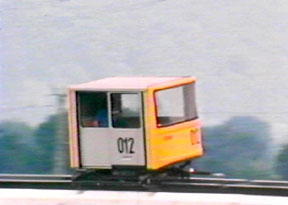Cabintaxi

Adapted from Wikipedia (2005)
The Cabinentaxi project, a German joint venture of Mannesmann Demag and Messerschmitt-Bolkow-Blohm, created the most extensive PRT development in history. The system was considered fully developed by the German Government and their safety authorities, and ready for installation in urban areas for carrying passengers.
Cabinentaxi development created three PRT systems in one, an over-running version (vehicle supported by guideway), an under-running version (suspended under guideway), and a combination of both, doubling route capacity. Besides the PRT aspects of the technology, the system had the ability to couple two 12 passenger vehicles and two 18 passenger vehicles to give the system added flexibility in the early stages where PRT networks were not yet mature, but higher capacity routes were desired. The system also had standing passenger versions of both the supported and suspended systems, giving Cabinentaxi the most flexible technology adaptability of any urban technology ever developed.
The system was considered one of the leading contenders for the US Downtown People Mover Program (1975-79), and was widely recognized as the favorite system to win the Detroit People Mover Project. Cabinentaxi's over-and-under beam was a major advantage over competitors, as the a single-beam system was specified, and "Cabintaxi" [Anglicized spelling?] was the only installation-ready technology in the world capable of bi-directional operation on a single beam.
Unfortunately, Cabinentaxi was planned to be installed in Hamburg during the same time, and it appeared the schedules for Detroit and Hamburg would overlap. The joint venture firms chose to withdraw from the US competition and concentrate efforts on Hamburg. This highly aggravated the largest funder, the German Ministry of Research and Technology, as the system had been developed with the thought of being an export product.
When the US Government requested increased defense spending on the part of the NATO allies, it resulted in mandatory budget cuts to all departments of the German government. The Ministry of Research and Technology withdrew funding with a statement citing, among other things, the failure to pursue the export market (specifically Detroit) and the mandated budget cuts.
The joint venture firms found themselves without a market opportunity in Europe or the United States, and withdrew from the public transit field. Shortly after a US firm calling itself Cabintaxi Corporation obtained the technology, and today continues to pursue private sector transportation applications based on the technology.
 Cabintaxi in the news, 1/18/2006.
Cabintaxi in the news, 1/18/2006.
Krauss Maffei Transurban
 (1974 video)
(1974 video)
Pictures:
Artist illustration
 Test facility
Test facility 
Cabinentaxi video
 (1972, YouTube)
(1972, YouTube)Hamburg deployment study

Cabintaxi in snow, showing mergepoint

1976 PRT/GRT study for German hospital district

8-person gurney-capable vehicle




